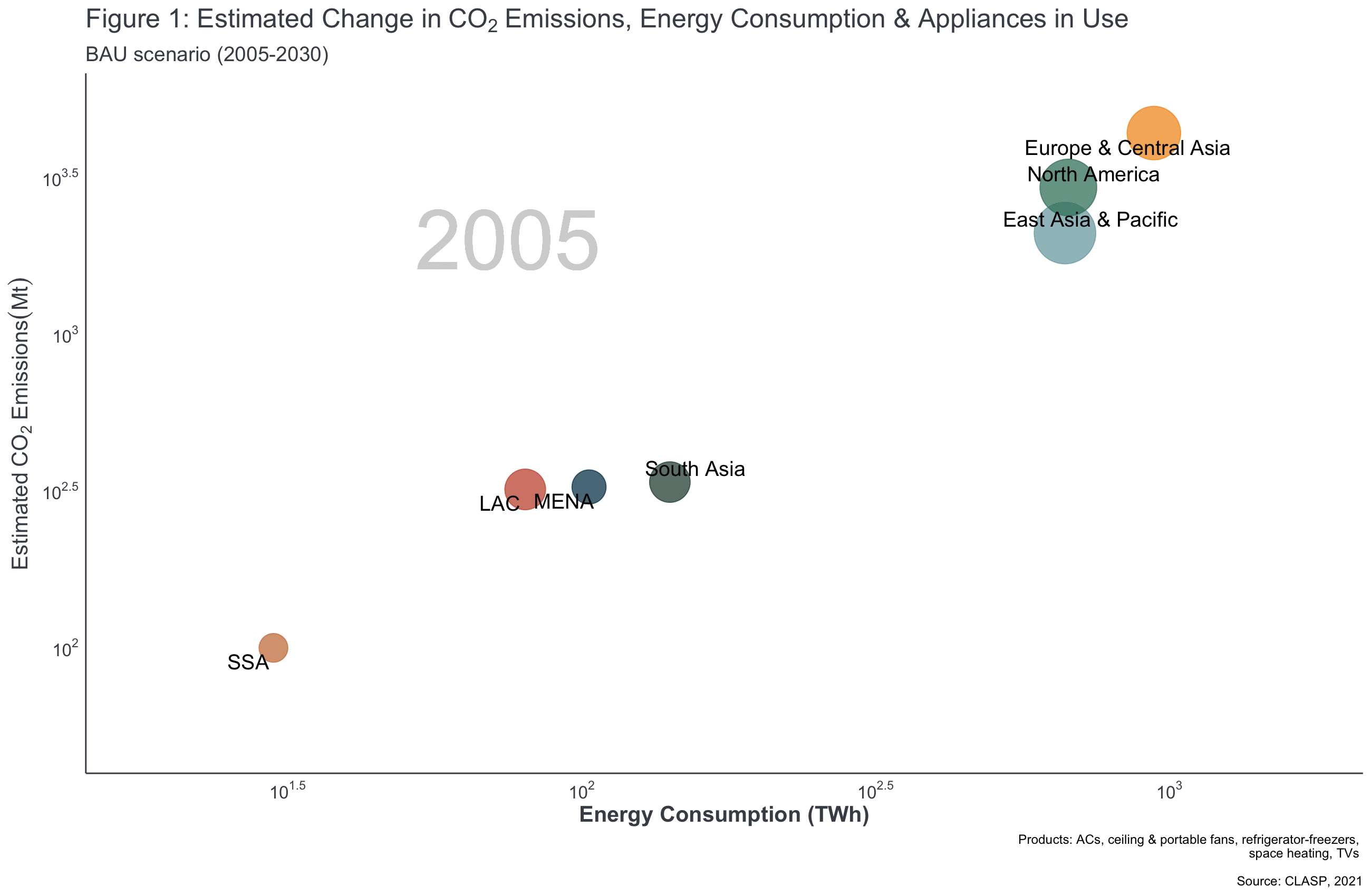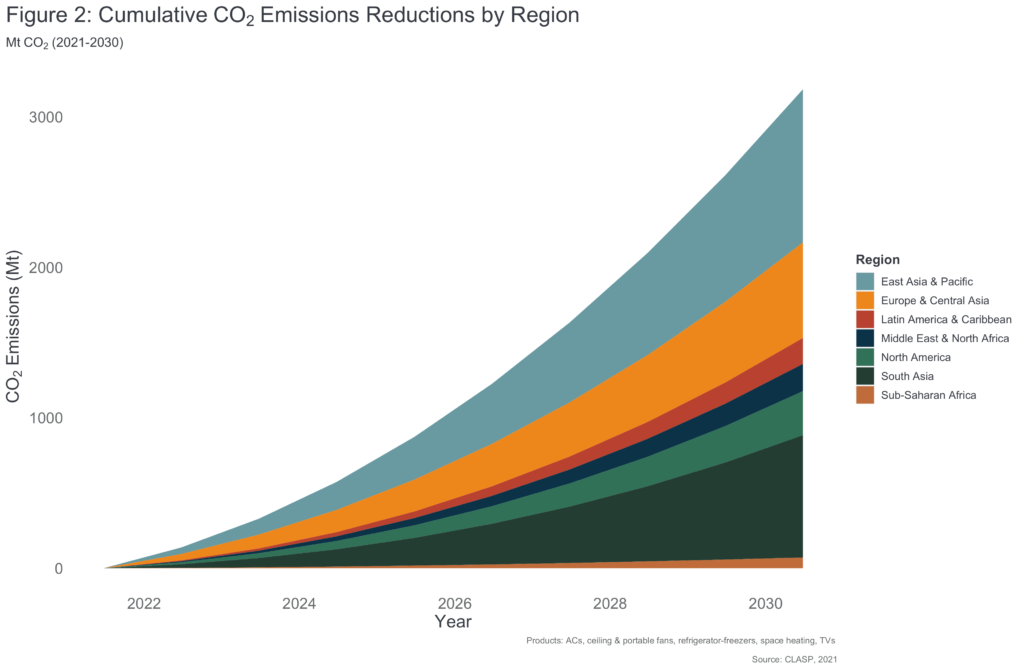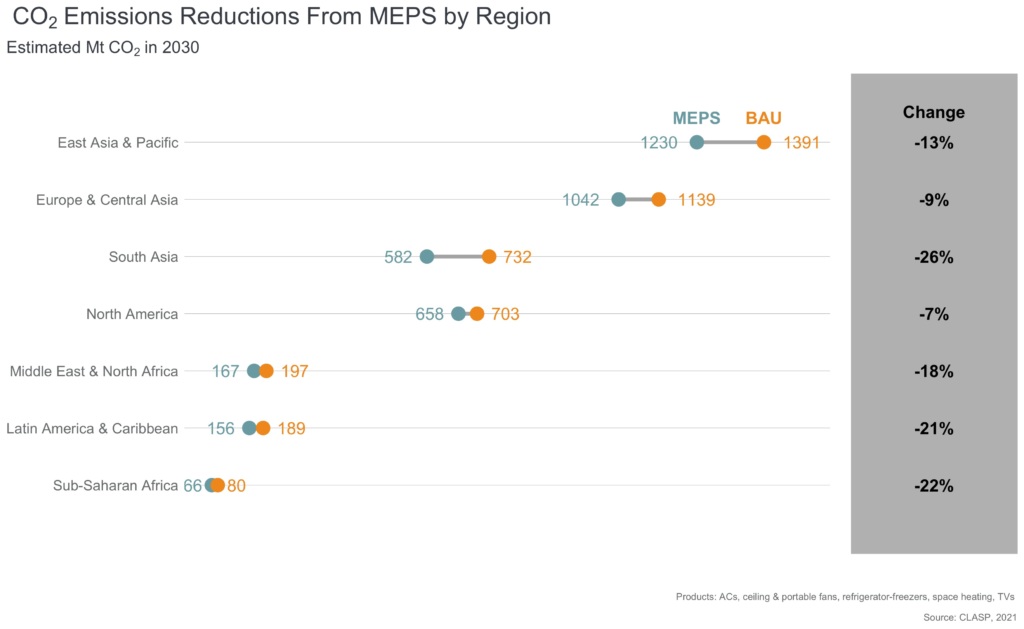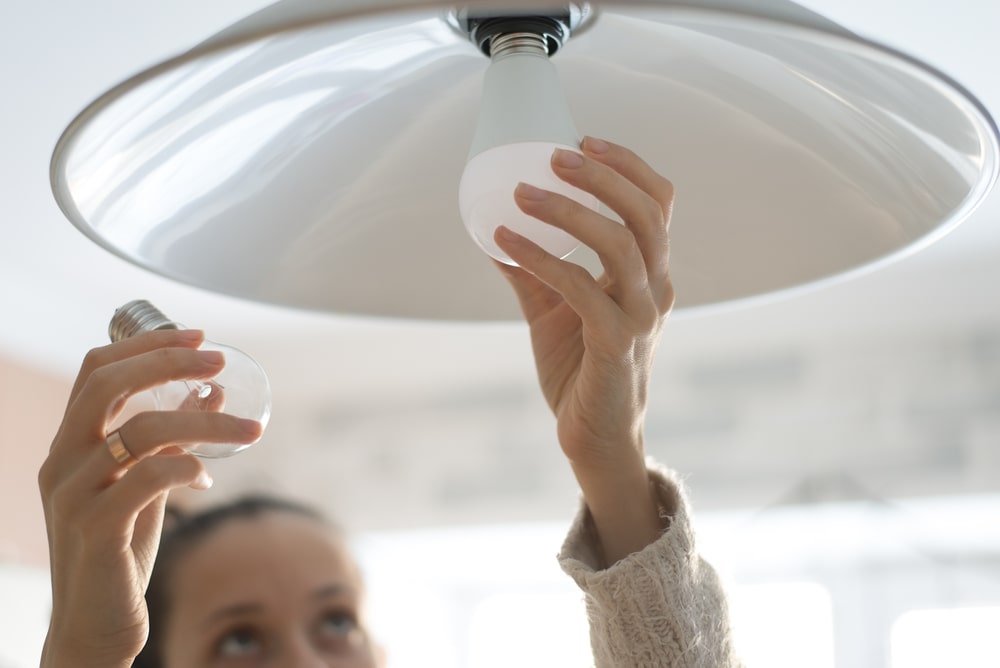Appliance Efficiency: An Underutilized Opportunity on the Path to Net-Zero Emissions
Analysis shows current climate commitments will not achieve the goals of the Paris Climate Agreement. By leveraging data from CLASP's new tool, Mepsy, Senior Associate Lauren Boucher explores how minimum energy performance standards can help raise the ambition of NDCs and lower global emissions by 2030.
This article uses an up-to-date analysis from CLASP’s new tool, Mepsy, to showcase the value of appliance efficiency policies and estimates the avoided CO₂ emissions that could be achieved if stringent minimum energy performance standards (MEPS) were adopted worldwide in 2021.
Energy efficiency plays a critical role in the race to a net-zero carbon economy. Investments in efficiency can reduce total demand for electricity, alleviate strain on the grid during periods of peak demand, and enable the early decommissioning of coal and other fossil-fuel power plants. Together these benefits can lower emissions while saving customers money on their electric bills. Efficiency improvements can contribute about half of the reduction in energy-related greenhouse gas emissions required over the next two decades to put the world on a path to meeting international energy and climate goals.
Energy efficiency is often touted as the “first fuel” of a sustainable energy system, but progress has often lagged behind development and investment in the power sector. According to the IEA, urgent action is needed: global efficiency improvements have been declining since 2015. Around the world, governments have incorporated energy efficiency measures into their energy and climate policies. In 2017, it was estimated that 68% of global energy use was not covered by efficiency codes or standards, still many opportunities remain untapped.
Of this untapped potential, appliance efficiency policies remain a bright spot for technical efficiency gains and climate action. 53 countries mention building energy efficiency in their Nationally-Determined Contributions (NDCs) to the Paris Climate Agreement. Of these, a smaller portion directly mention appliance standards. As countries continue to update and revise their NDCs, policies like minimum energy performance standards (MEPS), which aim to eliminate inefficient products, could have a large impact on global emissions. A forthcoming report from the IEA Technology Collaboration Programme on Energy Efficient End-Use Equipment (4E TCP) assesses the energy and climate achievements of standards and labeling programs in the commercial, residential and industrial sectors. It finds the electricity savings recorded from mature programs with the largest product coverage are encompass roughly 15% of total economy-wide electricity consumption.
Mepsy: CLASP’s Appliance & Equipment Impact Calculator
In February 2021, CLASP launched Mepsy, the appliance and equipment climate impact calculator. Mepsy is designed to help practitioners compare and prioritize appliance and equipment policy options. The free online tool displays the energy and climate impacts of appliance efficiency standards for key energy-using products and supports national, regional, and global analysis. Mepsy includes data for 162 countries and six products, and will soon be extended to include 10 product types, covering more than 75% of global residential and commercial energy use and more than 50% of global electricity use by industry.
Moving Beyond Business-As-Usual
Mepsy clearly communicates the value of appliance energy efficiency. In Figure 1 we plot annual emissions, energy consumption, and the total stock of appliances for five product classes (air conditioning, ceiling & portable fans, refrigerator-freezers, space heating, and televisions) by region (according to the World Bank’s regional classifications). The animation depicts changes in these variables over a 2005 to 2030 time frame under a business-as-usual scenario. The x-axis shows total energy consumption in terawatt-hours (TWh) on a logarithmic scale, and the y-axis shows CO₂ emissions in metric megatons (Mt) on a logarithmic scale. The area of each data point (shown as a bubble) corresponds to the total number of units in each region for that year.
The data reveal three important trends:
- Appliance markets in North America, Europe, Central Asia, and parts of East Asia are saturated, but efficiency opportunities remain as relevant as ever. The total number of appliance units in use grows only slightly from 2005 to 2030, suggesting that markets in North America and Europe & Central Asia are saturated. The total number of appliances in use in East Asia & the Pacific is projected to continue to grow through 2030, largely due to sustained economic growth in China. Mepsy data show the number of appliances in use for other countries in the region (e.g., Japan and South Korea) has remained relatively constant and similar to trends in Europe, Central Asia, and North America. A typical household in a high-income country owns between 15 and 40 different appliances with the market penetration of some appliances, like refrigerators and TVs, estimated at 100%. High levels of appliance ownership correlate with high energy consumption. Household energy consumption in the United States and Europe is 5-10 times greater than in India and 10-20 times greater than in Nigeria. High market penetration of appliances, coupled with high energy consumption creates significant opportunities for MEPS to deliver large climate impacts.
- South Asia and Latin America and the Caribbean (LAC) are high-value opportunities for timely efficiency policies. Penetration of appliances in middle-income countries varies by region and appliance type. In India, residential air conditioner ownership in cities exceeds 30%, while nationwide penetration is estimated at 4%. In Brazil, appliance sales and energy consumption are predicted to increase as these economies grow and disposable incomes rise. In the absence of strong efficiency policies and a push for low-carbon energy generation, this transition will lead to higher emissions. By adopting standards now, nations could alleviate stress on the electrical grid, while changing the trajectory of household energy consumption and CO₂
- Sub-Saharan Africa (SSA) has the potential to “leapfrog” inefficient and outdated technologies. Compared to other regions, energy consumption and CO₂ emissions from appliances in Sub-Saharan Africa are relatively low, largely due to low rates of electricity access and appliance ownership in rural areas. 580 million Africans lack access to electricity and rural households typically own between 2 to 5 appliances. Ensuring a balance of policies that expand energy access and increase energy efficiency will be critical to ensuring all households can harness the benefits of clean, affordable, and reliable power. For example, improving the efficiency of off-grid appliances enables households frees up additional capacity to run additional appliances on a solar home system. Quality standards can further help to ensure the benefits of energy access translate into social and economic gains by advancing consumer protection and facilitating the growth of clean energy.
Quantifying the Potential Climate Impacts
If minimum energy performance standards for air conditioning, ceiling and portable fans, refrigerator-freezers, space heating, and televisions are adopted globally in 2021, we could cumulatively avoid 3,184 Mt of CO₂ emissions from 2021 to 2030 (Figure 2). These cumulative savings are equivalent to the emissions produced by 803 coal plants in one year. Further, these gains could be achieved without requiring customers to radically alter their behavior, e.g., Mepsy does not include efforts that nudge consumers to use their appliances and equipment less. The largest reductions are predicted to occur in high-emitting, high-income regions (e.g., North America) and middle-income countries with growing economies and populations (e.g., South Asia and Latin America and the Caribbean).
Figure 3 further illustrates the emissions that could be avoided with the widespread adoption of MEPS worldwide. It depicts the estimated CO₂ emissions from five appliance classes under Mepsy’s BAU and efficient policies scenarios. 2030 CO₂ emissions from the BAU scenario are shown in orange, while emissions from the efficient policies scenario are shown in blue. The reduction in emissions (expressed as a percentage) from the BAU scenario is shown on the right.
Mepsy estimates that CO₂ emissions from appliances in North America and parts of Europe and East Asia will decline or slow in both the BAU and MEPS scenario. This reflects minimal changes in electricity consumption (i.e., terawatt-hours consumed vary little from year to year) and a declining grid emissions factor due to decarbonization in the power sector. As inefficient products reach their end of life and more efficient products take their place, both the energy consumed by these products and the CO₂ emissions associated with that consumption will decrease. While high energy consumption is projected to persist in North America, we estimate that 293 Mt in emissions savings (7% reduction from BAU scenario) can be achieved by adopting stringent MEPS. Countries in Europe and Central Asia can similarly reduce their collective emissions by 636 Mt by 2030 (a 9% reduction from BAU).
Emissions from appliance use in Latin America and the Caribbean and South Asia are all projected to rise through 2030. By adopting efficient policies now governments can significantly lower their CO₂ emissions by 2030. We estimate that if MEPS were adopted this year, emissions in Latin America and the Caribbean could cut 173 Mt and South Asia 813 Mt, a 21% and 26% decrease from BAU, respectively. These cumulative savings translate to the equivalent of taking over 214 million cars off of the road for one year or the emissions from nearly 250 coal power plants in one year.
Finally, if countries in Sub-Saharan Africa were to adopt MEPS for air conditioners, ceiling & portable fans, refrigerator-freezers, space heating, and televisions, they could prevent 71 Mt of CO₂ emissions between 2021 and 2030. While this number is small in comparison to other regions, adoption of MEPS would place the region on a sustainable trajectory by ensuring efficiency policies are in place as the region develops and more people are able to afford appliances.
Conclusion
The need to address the global climate crisis is becoming increasingly more urgent. New analysis of countries’ updated NDCs finds they must “re-double” their climate efforts to achieve Paris Agreement’s goal of limiting global temperature rise by 2°C, ideally 1.5°C, by the end of the century. As we look to COP26 later this year, appliance MEPS stand to play a large role in the global effort to increase ambition on collective climate contributions and turn far-away targets into immediate action.
About This Analysis
This analysis was performed using the pre-loaded data freely available in Mepsy, with a linear projection of grid emission factors and transmission and distribution losses (between the data in Mepsy, applicable today, and historical data from 2000 and 2002 from CLASP’s Policy and Analysis Modeling System (PAMS). Mepsy uses a bottom-up accounting method that accumulates unit sales and retirements to estimate the number of appliances in use in each country (the stock) and multiplies it by the average unit energy consumption (UEC) under two different policy scenarios: business-as-usual and efficiency policies (CLASP’s recommended worldwide MEPS, often harmonized with global initiatives such as UN Environment Programme’s United for Efficiency). CLASP regularly updates Mepsy’s underlying data to reflect the latest product shipments and efficiency.
Mepsy also enables users to run their own analysis for a given date range using their own shipment (sales), equipment (e.g., lifetime, price, energy consumption), economic (consumer discount rate), and energy sector data (e.g., electricity price, transmission losses, etc.). These custom features allow policymakers, researchers, and others to generate more precise estimates for a specific policy in a specific country. To leverage these features, please select “Run Detailed Analysis” or read our Quick Start Guide.
If you have any questions about Mepsy or its underlying methodology and assumptions, please contact us. CLASP offers custom workshops for practitioners, to request a training please send us an email with your name, organization name, organization size, and a short description of the product classes and/or policies of interest.












